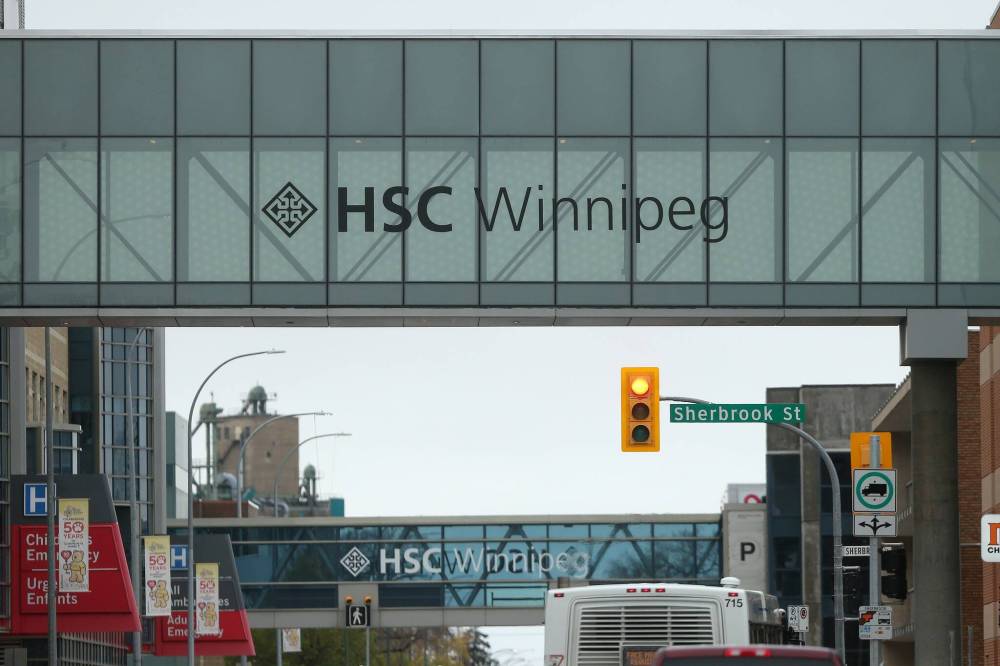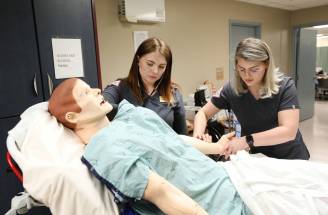‘It’s devastating’: doctor rings alarm bell over ER pressures
Read this article for free:
or
Already have an account? Log in here »
To continue reading, please subscribe:
Monthly Digital Subscription
$0 for the first 4 weeks*
- Enjoy unlimited reading on winnipegfreepress.com
- Read the E-Edition, our digital replica newspaper
- Access News Break, our award-winning app
- Play interactive puzzles
*No charge for 4 weeks then price increases to the regular rate of $19.00 plus GST every four weeks. Offer available to new and qualified returning subscribers only. Cancel any time.
Monthly Digital Subscription
$4.75/week*
- Enjoy unlimited reading on winnipegfreepress.com
- Read the E-Edition, our digital replica newspaper
- Access News Break, our award-winning app
- Play interactive puzzles
*Billed as $19 plus GST every four weeks. Cancel any time.
To continue reading, please subscribe:
Add Free Press access to your Brandon Sun subscription for only an additional
$1 for the first 4 weeks*
*Your next subscription payment will increase by $1.00 and you will be charged $16.99 plus GST for four weeks. After four weeks, your payment will increase to $23.99 plus GST every four weeks.
Read unlimited articles for free today:
or
Already have an account? Log in here »
Hey there, time traveller!
This article was published 25/10/2022 (1139 days ago), so information in it may no longer be current.
For the first time, 10 years into his medical career, Winnipeg emergency department physician Dr. Kristjan Thompson thought about quitting.
“For a split-second, I felt hopeless. I’m not hopeless. I’m motivated now more than ever to be part of the solution to solving this problem,” Thompson said of his Sunday shift at St. Boniface Hospital.
Faced with a packed waiting room, and patients on stretchers in the hallway, Thompson saw a triage nurse crying, feeling awful about a situation that was out of their control.
One of the ER patients waiting to see him had been there 18 hours with a bowel obstruction. Another waited 10 hours before being diagnosed with a heart attack (the signs of which weren’t readily apparent, Thompson said).
WINNIPEG FREE PRESS FILES Hospitals should have a “laser focus” on keeping the nurses they have before more leave the sector due to all-time high levels of burnout, said Dr. Kristjan Thompson, a Winnipeg emergency department physician.
“That patient was having a heart attack while they were waiting, and that is just unacceptable,” the past president of Doctors Manitoba advocacy group said Tuesday.
The emergency room wasn’t fully staffed, but the main problem was most of the patients there needed a bed elsewhere in the hospital. There was no room to assess and treat incoming patients while so many — roughly 42 of 50 beds — were occupied by patients who needed hospital admission.
Fear and burnout
As Manitoba doctors fear hospitals will be overwhelmed with patients this fall and winter, most of them are experiencing their own moral distress and burnout.
Manitoba Doctors, which represents more than 4,000 doctors, shared preliminary results from an ongoing survey in which 464 physicians have participated. Ninety-three per cent of them said they’re concerned about the state of hospitals.
As Manitoba doctors fear hospitals will be overwhelmed with patients this fall and winter, most of them are experiencing their own moral distress and burnout.
Manitoba Doctors, which represents more than 4,000 doctors, shared preliminary results from an ongoing survey in which 464 physicians have participated. Ninety-three per cent of them said they’re concerned about the state of hospitals.
This survey, combined with results from a previous annual physician survey that showed record high levels of professional burnout, present concerns that Dr. Kristjan Thompson, past president of Doctors Manitoba, said he has experienced.
Half of the doctors who responded to an annual survey earlier this year are showing signs of high or very high levels of burnout, based on the Maslach Burnout Inventory scale, Doctors Manitoba stated.
Thompson shared that 67 per cent of respondents (of 1,535 total) are experiencing moral distress in their work. He said he counts himself among the 67 per cent and described moral distress as “devastating.” He said it’s a feeling of not being able to care for patients at the level you want to, no matter how hard you try, because help is not available.
“It hurts your soul. It doesn’t even come close to what that patient is feeling. In that moment, they’re suffering. But it’s a form of vicarious trauma that all health-care workers absorb,” Thompson said.
The full report from Doctors Manitoba is expected to be published later this week.
That left the second-largest hospital in the province with eight beds to treat incoming ER patients last weekend, Thompson said. One has been waiting for more than six days in the emergency department for an in-patient bed; five others have been waiting longer than four days; 11 have been waiting two days, the doctor said.
The department tried to call in extra help, only to be told none was available.
“It’s devastating,” Thompson said. “And as hard as it is for me to see, I can’t imagine what those folks waiting are feeling.”
After tweeting about the “quite dire” situation Monday morning, Thompson held a virtual news conference Tuesday through Doctors Manitoba.
The working conditions in provincial ERs are unreasonable and getting worse, he said — but there are short-term fixes that could help while long-term nursing recruitment continues.
Hospitals should have a “laser focus” on keeping the nurses they have before more leave the sector due to all-time high levels of burnout, Thompson said.
They also need to put in place a “surge protocol” for ERs, which already has been tested and proven to work, he added. It would require changing the way hospital wards admit and discharge patients, such as finding an alternate waiting spot for a soon-to-be-discharged patient that would free up a bed.
“It’s devastating… And as hard as it is for me to see, I can’t imagine what those folks waiting are feeling.”–Dr. Kristjan Thompson
“It’s an attempt to try and spread that risk over the health-care system. But we have to do it in a safe way, because the wards are stretched just as thin as the emergency department, so it’s not simple. It’s complicated, but it’s been trialed and it can be done,” Thompson said.
Asked for comment about Thompson’s social media posts, the Winnipeg Regional Health Authority didn’t directly respond.
It instead provided data showing high median wait times at the St. B ER over the past week. From Oct. 17-22, a daily average of 110 patients accessed the department. The median length of stay in the ER for admitted patients was more than 20 hours each day, up to 28.3 hours Oct. 22. Half of patients would have waited longer.
In August and September, the daily average median length of stay was 26 hours.
Patient flow in city ERs is a problem, a WRHA spokeswoman acknowledged, but the authority stated it hasn’t affected care for critically ill patients.
“These challenges, while significant over the weekend, did not impact the overall ability of the provincial critical care program to maintain capacity. There was, however, a delay in moving one individual at Grace Hospital on Sunday (Oct. 23) from its emergency department to ICU due to staffing challenges and the high acuity of patients already in the unit. The patient’s care was not impacted, although it did cause lower-acuity patients to wait longer for care in emergency,” the WRHA stated.
Asked about surge protocols, the WRHA said it is in the process of rolling out surge protocols in the adult ER at Health Sciences Centre, and has already implemented it in HSC surgery units.
SHANNON VANRAES / WINNIPEG FREE PRESS FILES The WRHA said it is in the process of rolling out surge protocols in the adult ER at Health Sciences Centre, and has already implemented it in HSC surgery units.
“The protocol uses a number of criteria to evaluate access block, patients waiting, EMS arrivals and admitted patients according to a four-level scale. Each level has activities and assignments intended to improve flow and access, including moving patients from the ED to inpatient units based on their needs and length of stay,” the statement reads.
Thompson said he aimed to find out why ER surge protocols haven’t yet been put in place at a scheduled meeting Tuesday afternoon with WRHA chief executive officer Mike Nader. The doctor said he was encouraged leaders are listening and having these discussions, and is hopeful things will improve.
Thompson encouraged the public to continue to seek medical attention, despite the current conditions in ERs.
“I know it’s scary to hear these things, but when it’s busy, patients are triaged, and those with the most life-threatening conditions are seen as quickly as possible.”
“When a physician like this speaks out, we really have to listen… and deploy our investments to meet the challenge of the moment.”–NDP leader Wab Kinew
Manitoba NDP Leader Wab Kinew said Thompson’s comments are “very concerning,” and point to the health-care system getting worse.
“When a physician like this speaks out, we really have to listen… and deploy our investments to meet the challenge of the moment,” Kinew said Tuesday.
katie.may@freepress.mb.ca

Katie May is a general-assignment reporter for the Free Press.
Our newsroom depends on a growing audience of readers to power our journalism. If you are not a paid reader, please consider becoming a subscriber.
Our newsroom depends on its audience of readers to power our journalism. Thank you for your support.
History
Updated on Tuesday, October 25, 2022 10:18 PM CDT: Notes Thompson is past president of Doctors Manitoba













